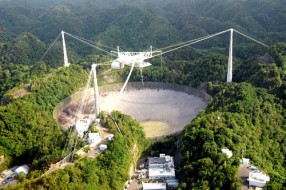
NAIC
Astronomical research is almost solely dependent on information we gather from the light of celestial bodies — their brightness, color, and movement. For millennia, humans could only observe the cosmos in visible light, but visible light constitutes only a tiny portion of the universe’s radiation. The electromagnetic spectrum contains all radiation, from the longest wavelengths (lowest frequencies) to the shortest wavelengths (highest frequencies). Longer wavelengths correspond to lower-energy photons, and the lowest of these are radio waves. Radio astronomy is the study of the universe through analysis of radio emission from celestial objects.
Radio waves cut more easily through interstellar gas and dust, because they are not as easily scattered or absorbed as other, shorter-wavelength radiation. Some particularly strong sources of radio emission in the universe include active galactic nuclei (thought to be powered by supermassive black holes) and spinning stellar corpses known as pulsars. Closer to home, ham radio operators can most easily pick up the Sun and Jupiter, and with some fine-tuning, meteor showers. (NASA's Radio Jove project can get you started doing the same in your own backyard.)
Radio telescopes use large, parabolic dishes to reflect incoming radio waves to a central focus above the dish, where the signal is received and amplified. Then, a computer can process the amplified signals to create an image that follows the shape of the radio signal, using false colors to portray the relative intensity of radio emission at various points. Radio telescopes are much larger than optical telescopes because radio waves have such low energies; in order to detect a signal, radio telescopes must be able to capture many more photons than optical telescopes.
Astronomers can also use arrays of radio telescope dishes to conduct very long baseline interferometry. This technique combines observations from multiple radio telescopes in separate locations, such that the image resolution is equivalent to what you’d have if you used one telescope as large as the baseline separation between the telescopes — which can be thousands of miles. The most widespread combination of radio telescopes is known as the Event Horizon Telescope. Though still under construction, astronomers hope this array will one day, among other things, image the silhouette of the Milky Way's central supermassive black hole.
 0
0









Comments
You must be logged in to post a comment.